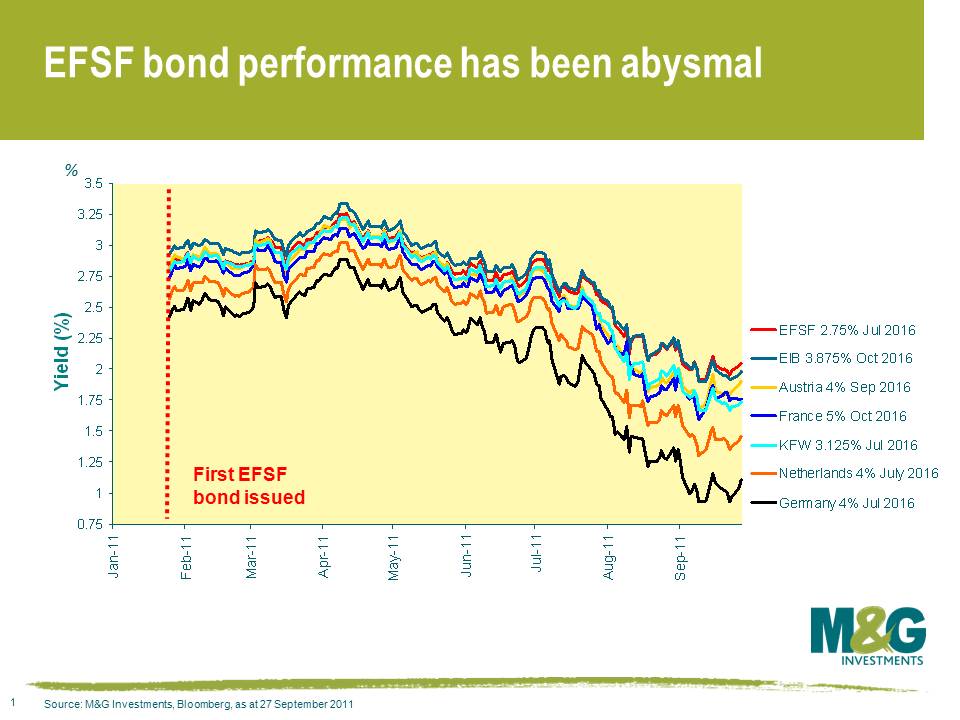10 reasons why EFSF is not the Holy Grail
We’ve had numerous concerns with EFSF ever since it was announced last year. Here’s our top 10, in no particular order;
(1) The considerable risk of one or more of the AAA rated guarantors being downgraded, which would threaten EFSF’s AAA rating.
(2) The fact that the EFSF’s current size and form aren’t sufficient to bail out Spain and Italy.
(3) A larger EFSF, which solves point (2), could weigh on sovereign ratings and result in problem (1).
(4) Legal risk. Investors in EFSF bonds have no understanding of what the money is to be used for (initially investors were told the facility was not to be used for bank bailouts but that looks likely to change). And if an EFSF guarantor reneges on its guarantee then there’s no payback (so if Slovakia pulls out, Germany just ends up guaranteeing more).
(5) Some of the initial guarantors (Spain and Italy) are themselves in trouble and probably need bailing out. If problem (3) is somehow overcome, then that means more EFSF bonds. But then you run into the problem of fungibility. Each EFSF bond has different guarantors, so the first EFSF bond was issued in January to bail out Ireland. Portugal remains to this day one of the guarantors for that particular bond, despite Portugal itself also needing to be bailed out (the two subsequent EFSF issues were to bail out Portugal, of which obviously neither Portugal nor Ireland are guarantors)
(6) The existence of yet another large AAA rated supranational entity will presumably crowd out private sector issuers, governments and particularly other supranational or agency entities, pushing up borrowing costs. Linked to this, the existence of yet another AAA rated supranational entity will get investors wondering about the strength of the sovereign support for those EU financing structures that (unlike EFSF) don’t have an ‘explicit’ guarantee.
(7) Further down the road, if bank or sovereign restructuring is necessary and the EFSF guarantors need to pay out to the EFSF investors, then the guarantors will need to raise money by issuing bonds, which increases debt levels, which leads you back to point (1).
(8) A sovereign restructuring would be proof that the EFSF support mechanism and fiscal discipline measures have failed. This wouldn’t be a surprise – EFSF doesn’t reduce debt burdens or encourage debt sustainability. It does nothing to address solvency.
(9) There’s been enough trouble designing the EFSF, but it is only supposed to last until 2013, at which point we start all over again with the European Stability Mechanism (ESM). And the ESM potentially subordinates the EFSF, taking seniority over existing creditors.
(10) EFSF is not prefunded. Investors need to be persuaded to part with billions of euros to invest in a vehicle with an ever-expanding mandate that lends money to European governments and banks at precisely the time when the market has decided that those governments and banks are insolvent.
Let’s focus on the last point. So far only €13bn of EFSF bonds have been issued; two five year bonds and one ten year bond. It looks like the intention is for many, many billions more to be issued. So the supply of EFSF bonds sharply increases, and at the same time, investor demand will likely fall as investors become increasingly uncomfortable about lending to the EFSF for all the reasons listed above. Supply up, demand down, not a good combination.
The chart below shows that the market is already losing confidence. Despite being ‘guaranteed’ and priced to perform when issued (and hence massively oversubscribed), the first EFSF bonds that came to the market in January now yield 100 basis points more than German government bonds. Curiously they also now yield more than European Investment Bank (EIB) bonds, where EIB debt only has an implicit guarantee from member states. A continuation of this trend will likely result in the ECB being the only end buyer of EFSF, which is something that the Northern Europeans are desperate to avoid.
The value of investments will fluctuate, which will cause prices to fall as well as rise and you may not get back the original amount you invested. Past performance is not a guide to future performance.


18 years of comment
Discover historical blogs from our extensive archive with our Blast from the past feature. View the most popular blogs posted this month - 5, 10 or 15 years ago!


Bond Vigilantes
Get Bond Vigilantes updates straight to your inbox






